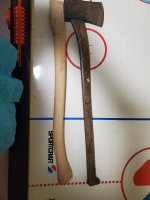- Joined
- Mar 16, 2017
- Messages
- 256
- Reaction score
- 426
I'm going on a trip in a few weeks and one of the group gear items listed is "axe". It appears there are two coming along in our group of 6. That would seem to be more than enough, however, when I mentioned that I would want to use one to split up some cooking fire sized pieces, I got a lecture on how using a rock for a splitting stump will ruin an axe. So, considering the "just a minute" response I might get when asking the Havers of Axes for some firewood (I'm the only one planning to cook over the fire), would you bring your own axe?
By the way, I don't actually need an answer, but rather just interested in hearing some axe-murderer stories in which the axe is the victim.
By the way, I don't actually need an answer, but rather just interested in hearing some axe-murderer stories in which the axe is the victim.



